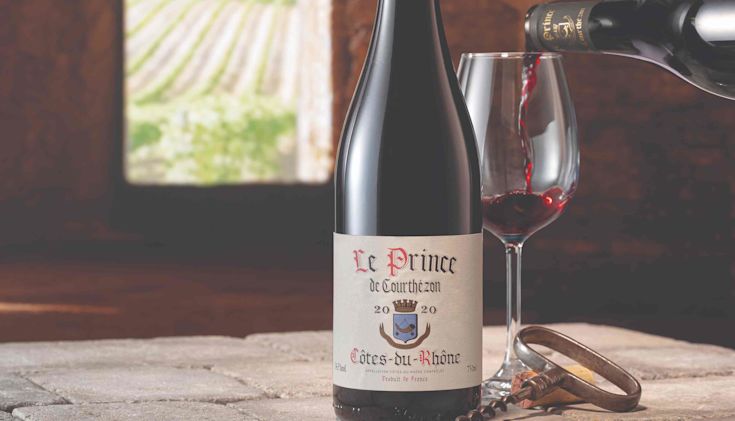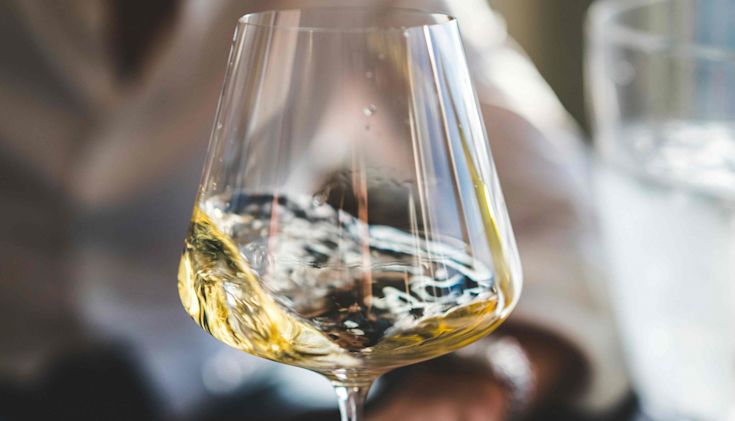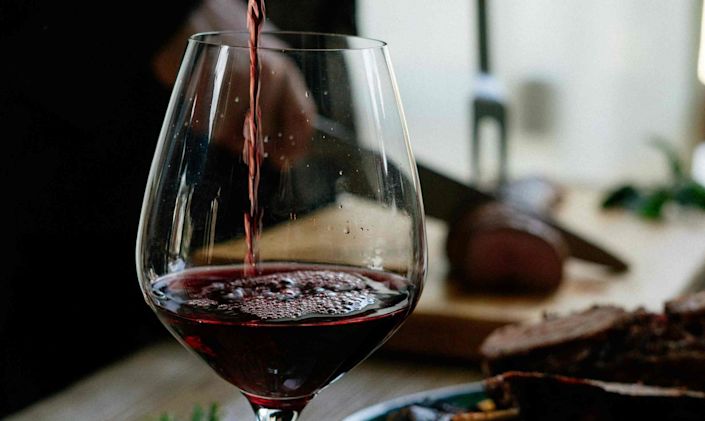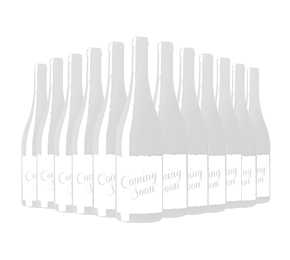Chat with Vinny
The Rhône Valley is one of France’s most important wine regions, up there with the big names like Bordeaux, Burgundy, and the Loire. And it has so much to offer wine lovers – from warming red blends and elegant pure Syrahs to luxuriously rich whites and more. Find out all you need to know in our beginner’s guide.
What kind of wine is the Rhône Valley known for?
The first thing to know about the France’s Rhône Valley wine region is that it divides into two distinct areas.
The southern Rhône is known chiefly for its red blends. These are made mostly from Grenache, Syrah and Mourvèdre (a recipe so successful that it has been adopted by the Aussies, who label their blends GSM). Half is bottled under the Côtes-du-Rhone AOC appellation – and they tend to be rich, warming and packed with spicy bramble fruit flavours. The region’s most revered red, however, is Châteauneuf-du-Pape (aka CNDP). CNDP can be made from up to eighteen different grapes – but most are made from Grenache, Syrah and Mourvèdre, with perhaps one or two other varieties. Some good whites are also made here.
The northern Rhône is known mostly for its pure Syrah (the grape known as Shiraz in Australia) reds. With its steep hillsides, there is much less land under vine than the southern Rhône, and vineyards here – especially on the higher slopes – are very precious. The most famous wines of the northern Rhône are Hermitage and Côte-Rôtie. The region also produces some highly regarded fine whites – including the fabulously rich, hedonistic Condrieu.
What are the best-known red wines of the southern Rhône?
The best-known red wine of the southern Rhône is classic Côtes-du-Rhône AOC red. Made from the signature GSM blend, these reds tend to be richly fruity with warming spice notes. They’re great value, and reliably delicious – so if you’re in a restaurant and want to pick a red that isn’t too pricy and won’t disappoint, a Côtes-du-Rhône AOC is always a good bet.
But there are many other southern Rhône wines (both red and white) worth looking out for. Here’s a list of the top names you need to know:
Châteauneuf-du-Pape
Châteauneuf-du-Pape is the most famous red of the southern Rhône, adored for its big spice and warm, ripe, velvety fruit. It lies at the heart of the Côtes-du-Rhône region, where the best vineyard sites are found. (Like many French wine appellations, the more specific the geographical designation, the higher the status of the wine).

The name Châteauneuf-du-Pape literally means ‘The Pope’s new castle’ – and refers to the time in the 14th century when the Pope relocated his palace to Avignon. He had previously been partial to the great wines of Burgundy – but soon developed a taste for the bold yet elegant reds from vineyards surrounding the papal palace.
One of the regions more striking features is the carpet of large stones (known locally as galets roulés) that cover the ground in the vineyards. These are said to help the grapes to ripen – by storing the heat from the day and releasing it at night.
Another unusual feature of Châteauneuf-du-Pape is that there are 18 permitted grape varieties that can be used in its wines. A few of these are white and in fact both red and white grape varieties are allowed in both red and white Châteauneuf-du-Pape. In practice, most reds are made from far fewer grape varieties – with Grenache being the mainstay, giving that classic rich brambly character. Syrah adds depth and spicy blackberry notes, while Mourvèdre adds peppery black fruit, elegance, and structure.
Similarly, white Châteauneuf-du-Pape is made mostly from two varieties, Grenache Blanc and Roussanne. These two grapes give the wine a rich, honeyed character that makes them highly prized, while Bourboulenc, Picpoul and Clairette add freshness and floral notes.
Côtes-du-Rhône Villages AOC
The Côtes-du-Rhône Villages AOC was created in recognition of the fact that some of the villages in the southern Rhône were making consistently better wines. Of these, 22 are allowed to append their village name to the label – most notably Chusclan, Séguret, Sablet and Plan de Dieu. These wines are seriously worth looking out for, as they have worked hard to gain their status – and they provide excellent value alternatives to the wines of Châteauneuf-du-Pape.
Some of the Côtes-du-Rhône Village AOC wines have been granted AOC status in their own right. Notable examples include Vacqueyras AOC and Rasteau AOC – both are well worth seeking out.
Gigondas
Gigondas lies about 10 miles southwest of Châteauneuf-du-Pape, and the wines of the two regions are often compared. Many see Gigondas as a better-value alternative to the wines of Châteauneuf.
Despite their proximity, the soils are different. In place of the famous galets roulés of Châteauneuf, Gigondas has sandy, gravelly soils. These provide good drainage and result in intensely flavoured wines. But the climate is of course similar – and favours the same grape varieties. All Gigondas red wines must comprise at least 50% Grenache – with the remainder made up of Syrah, Mourvèdre and Cinsault.
There isn’t space to list all the villages and appellations here, so our best advice is – explore our great selection of Rhône reds!

What are the best-known white wines of the southern Rhône?
Although the southern Rhône is best known for its reds, there are some great whites to discover, too.
Most whites in the southern Rhône are also bottled under the Côtes-du-Rhône AOC appellation. The most common grapes are Grenache Blanc, Clairette, Bourboulenc along with Marsanne, Roussanne and Viognier. Usually rich in texture and nicely rounded, they offer flavours ranging from apple and peach to honeysuckle and apricots. If you like rich, tropical flavours – and you’re looking for an alternative to Chardonnay – a white Côtes-du-Rhône is a great choice.
If you want to take a step up in fine wine quality – opt for a Châteauneuf-du-Pape Blanc. These whites are very similar in style to white Côtes-du-Rhône – but with greater intensity, elegance, and complexity. Looking for the perfect Christmas dinner white? You just found it!
What are the best-known red wines of the northern Rhône?
The northern Rhône is the classic French region for Syrah – the grape known in Australia and South Africa as Shiraz. This is a much hillier region than the southern Rhône, with many steeply terraced vineyards.
The steep slopes also provide excellent drainage for the vines as well as good exposure to the sun, resulting in small yields of well-ripened, intensely flavoured grapes of immense depth. The higher, cooler altitude provides a longer ripening period, too, helping to produce more elegant wines. These factors combine to produce some of the finest Syrah wines in the world. However, the terraced vines make vineyard management hard work, yields are low and land here is expensive. So northern Rhône reds tend to be pricy.
Here’s a handy guide to the best-known northern Rhône reds.
Hermitage
This is the best-known northern Rhône red, named after the famous hill of Hermitage on which the vineyards lie. Hermitage wines must be made purely from Syrah. The wines tend to be traditionally made, with fermentation in large wooden vats and ageing in oak barrels. These are among the longest-lived reds of the Rhône and can age gracefully for decades.
Hermitage reds are typically rich and full bodied with complex aromas of black fruits and spice, often with notes of smoky bacon, menthol, and liquorice. Elegantly structured, they offer red and black fruit flavours including blackberry, blueberry, and strawberry, with notes of spicy oak and olives.
Crozes-Hermitage
This appellation covers the vineyards surrounding and immediately below the hill of Hermitage. While they may not reach quite the heights of Hermitage, Crozes-Hermitage reds are very similar in style. These are still very fine wines and offer a great-value alternative to those of the more exclusive Hermitage region.
Saint-Joseph
Another classic northern Rhône region, Saint-Joseph is very similar in style to Crozes-Hermitage, but perhaps a little lighter in style. Producers here are very keen to get more recognition for their wines – and as a result, Saint-Joseph reds often offer excellent value for money. Expect complex red and black fruit flavours with notes of minerals, herbs, and liquorice.
Côte-Rotie
These are some of the finest and most exclusive reds of the northern Rhône. Its name means ‘roasted slope’ – referring to the steep, sun-soaked south-facing slopes. Like Hermitage, these are hard work to manage – but repay the efforts with exceptionally fine reds.
The Côte-Rôtie appellation is unusual in that the AOC regulations allow up to 20% Viognier in the reds – lending the wines a delicate, aromatic character. The wines typically offer expressive aromas of spicy bramble fruit, liquorice, coffee, violets, and olives and Syrah’s classic edge of black pepper.
What are the best-known white wines of the northern Rhône?
The northern Rhône is also home to some superb whites – in some cases even more highly prized than the reds. The principal grape varieties are Roussanne, Marsanne and Viognier, and the wines tend to be rich and luxurious, floral, and complex, with a nervy edge of minerality.
The classic northern Rhône regions of Hermitage and Saint-Joseph also produce whites – but there are two exclusively white wine appellations worth looking out for too:
Condrieu
These are some of France’s, if not the world’s most sought-after whites. Made purely from Viognier, they are unctuous, golden and decadent, with flavours of peaches and apricots, and orange, honey and blossom notes. Definitely a wine to experience if you can.
The region is also home to Château-Grillet, a tiny property that is also its own AOC – making it the smallest appellation in France. Needless to say, its wines are as pricy as they are exclusive and delicious.
Saint-Péray
This appellation is unusual for the northern Rhône as it makes only still and sparkling white wines. Both are made from Marsanne and/or Roussanne, giving them a floral character.
The sparkling wines are made, like Champagne, using the Traditional Method, and producing a fine fizz that’s both elegant and easy drinking. The still whites are becoming more popular in the region and are prized for their delicacy and finesse.

What is the best food to pair with Rhône Valley wines?
The Grenache-rich reds of the southern Rhône reds are perfect alongside hearty dishes such as braised lamb shanks or steak and kidney pie. Their bold spicy flavours also make them a great choice with game dishes – venison sausages with a wild mushroom sauce perhaps. Made purely from Syrah, northern Rhône reds tend to be more finely structured, with deep black fruit flavours and peppery spice notes. Serve with plain roast meats such as beef or lamb to allow the wine to really shine.
Rhône whites have a rare combination of richness and floral complexity that makes them a natural fit for sauced seafood and poultry dishes. Condrieu, the most luxurious white Rhône of all, can partner even more rich foods – richly sauced monkfish or lobster thermidor perhaps. Definitely an excuse to pull out all the stops in the kitchen.

Where to start with Rhône wines?
As you’ll have seen, the Rhône has a tremendous amount to offer the adventurous wine lover – from the rich, warming and pocket-friendly reds of the southern Côtes-du-Rhône to the elegant Syrahs and luxurious whites of the north. If you’re new to the region, why not start with a reliably delicious Côtes-du-Rhône red a Crozes-Hermitage? And for whites – plump for a southern Côtes-du-Rhône Blanc as a delicious alternative to Chardonnay.
About the author
Chris Larkin
A seasoned copywriter with over two decades experience, Chris has been part of the team since 2021. At Laithwaites HQ, you’ll find him either working on our latest catalogue or creating informative content for our website. Qualified to WSET Level 3 Wine, Chris is as geeky about wine as he is about copywriting. But when it comes to choosing a special bottle, he is a traditionalist, and loves a good Bordeaux or Mâcon Chardonnay.

